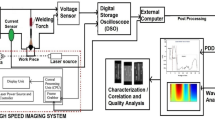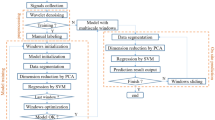Abstract
Condition monitoring of welding processes have received considerable attention in recent years. The method proposed in this paper provides a novel and a better method for analysis of the weld joint strength, i.e., the adaptive chirplet transform. The presence of the nonlinearities in the various sensor outputs of the monitoring systems of the welding procedure demands a more precise signal processing method for a more accurate analysis of the weld joint strength. The adaptive chirplet method has been used here which produced much better results than the other statistical signal processing methods like the wavelet transform technique due to a better time–frequency resolution of the same. In nonlinear feature extraction, wavelet transform technique was first used to detect the weld joint strength using current as a sensor output during the welding. Then the similar procedure was followed using the adaptive chirplet analysis technique which not only showed better differencing capacity between various signals but also provided better time–frequency resolution for the experimental cases where the wavelet method could not predict the weld joint strength correctly. A thorough laboratory study shows that the diagnostic method proposed in this paper is much more accurate, has high sensitivity with respect to faults, and also has better diagnostic resolution.
Similar content being viewed by others
References
Nouri M, Abdollah-zadehy A, Malek F (2007) Effect of welding parameters on dilution and weld bead geometry in cladding. J Master Sci Technol 23:817–822
Karadeniz E, Ozsarac U, Yildiz C (2007) The effect of process parameters on penetration in gas metal arc welding processes. Master Des 28:649–656
Chen MA, Wu CS, Li SK, Zhang YM (2005) Analysis of active control of metal transfer in modified pulsed GMAW. Sci Technol Weld Join 12:10–14
Ghosh PK, Gupta SR, Randhawa HS (2000) Characteristic of a pulsed-current, vertical-up gas metal arc weld in steel. Metall Mater Trans A 31A:2247–2259
Balasubramaniam V, Ravishankar V, Madhusudhan Reddy G (2008) Effect of pulsed current welding on mechanical properties of high strength aluminium alloy. Int J Adv Manuf Tech 36:254–262
Randhawa HS, Ghosh PK, Gupta SR (1998) Geometrical characteristics of pulsed current positional GMA weld. ISIJ Int 38:276–284
Randhawa HS, Ghosh PK, Gupta SR (2000) Some basic aspects of geometrical characteristics of pulsed current vertical-up GMA weld. ISIJ Int 40:71–76
Rajasekaran S (2000) Surface topography of pulsed current gas metal arc clads. Surf Eng 16:495–500
Kumar R, Dilthey U, Dwivedi DK, Sharma SP, Ghosh PK (2008) Welding of thin sheet of Al alloy (6082) by using vario wire DC P-GMAW. Int J Adv Manuf Tech. doi:10.1007/s00170-008-1568-4
Padmanabham G, Schaper M, Pandey S, Simmchen E (2007) Tensile and fracture behavior of pulsed gas metal arc-welded Al-Cu-Li. Weld J 86:147s–160s
Kumar R, Dilthey U, Dwivedi DK, Ghosh PK (2009) Thin sheet welding of Al 6082 alloy by AC pulse-GMA and AC wave pulse-GMA welding. Mater Des 30:306–313
Balasubramanian V, Ravisankar V, Madhusudhan Reddy G (2007) Effect of pulsed current and post weld aging treatment on tensile properties of argon arc welded high strength aluminium alloy. Mater Sci Eng 459:19–34
Pal K (2010) Multi-sensor based monitoring and modeling of Pulsed GMAW Process. Indian Institute of Technology, Kharagpur
Pal S, Pal SK, Samataray AK (2008) Neurowavelet packet analysis based on current signature for weld joint strength prediction in pulsed metal inert gas welding process. Sci Technol Weld Join 13(7):638–645
Mann S, Haykin S (1992) The chirplet transform: physical considerations. IEEE Trans Sig Process 41(11):2745–2761
Qingwei G, Yixiang Lu, Yanfei Z (2007) Bearing vibration signal analysis based on chirplet transform. IEEE Eighth ICEMI 4:437–440
Guo Q, Yu H, Hu J (2008) A method for condition monitoring and fault diagnosis in electromechanical system. Springer Neural Comput Applic 17:373–384
Feng Z, Chu F (2007) Nonstationary vibration signal analysis of a hydroturbine based on adaptive chirplet decomposition, SAGE publications, vol.6(4):0331–15, 265–279
Mann S, Haykin S (1992) Adaptive “Chirplet” transform: an adaptive generalization of wavelet transform. Opt Eng 31(6):1243–1255
Keinert F (2004) Wavelets and multiwavelets, studies in advanced mathematics, vol. 42. Chapman & Hall/CRC, Boca Raton, ISBN 1-58488-304-9
Candes EJ, Charlton P, Helgason H (2007) Detecting highly oscillatory signals by chirplet path pursuit, Science Direct. Appl Comput Harmon Anal 24:14–40
Author information
Authors and Affiliations
Corresponding author
Rights and permissions
About this article
Cite this article
Chatterjee, S., Chatterjee, R., Pal, S. et al. Adaptive chirplet transform for sensitive and accurate monitoring of pulsed gas metal arc welding process. Int J Adv Manuf Technol 60, 111–125 (2012). https://doi.org/10.1007/s00170-011-3597-7
Received:
Accepted:
Published:
Issue Date:
DOI: https://doi.org/10.1007/s00170-011-3597-7




